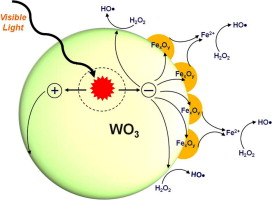Publication
Advanced Redox Technology Lab
Publication
Advanced Redox Technology Lab
Journal papers
WO3-mediated photocatalytic oxidation is achievable in the presence of electron acceptors as an alternative to O2 or co-catalysts enabling O2 reduction pathway. This study suggests the combination with Fenton-like reagent (Fe(III)/H2O2) as a strategy to improve the photocatalytic activity of WO3. Under neutral pH condition where Fe(III) is present as iron oxide precipitate, photocatalytic degradation of 4-chlorophenol (4-CP) proceeded 3-fold faster in the WO3/Fe(III)/H2O2 system relative to the WO3/H2O2 system, while no noticeable oxidation occurred in the systems of Fe(III)/H2O2, WO3, and WO3/Fe(III). Such efficacy increase at circumneutral pH was observed in photocatalytic oxidation of diverse organics including phenol, bisphenol A, acetaminophen, and carbamazepine. Compatible with the pH dependence of photocatalytic activity of the WO3/Fe(III)/H2O2 system, hydroxylation of benzoic acid and coumarin as indirect indication for OH radical production was drastically retarded with increasing pH. The pH effect indicates that OH radical as primary oxidant may be responsible for the kinetic enhancement in the WO3/Fe(III)/H2O2 system. In that platinum deposits or Nafion layers as physical barriers possibly inhibit surface Fe(III) precipitation, use of platinized or Nafion-coated WO3 caused the negligible photocatalytic improvement in the ternary system. Effective oxidative degradation in the presence of the UV cut-off filter corroborated visible light activation of the WO3/Fe(III)/H2O2 system.
